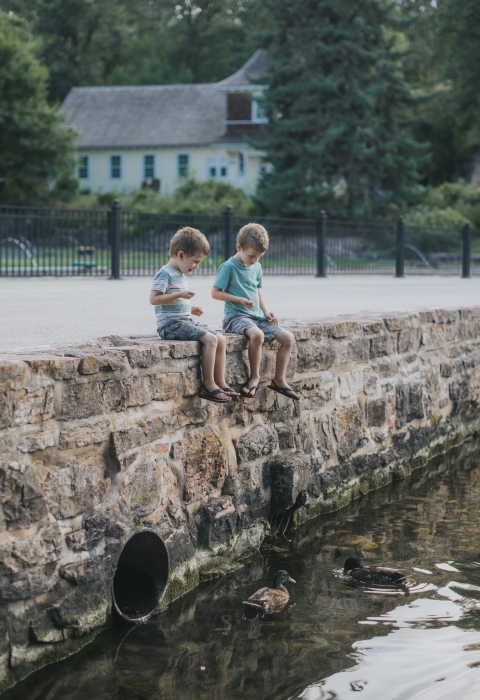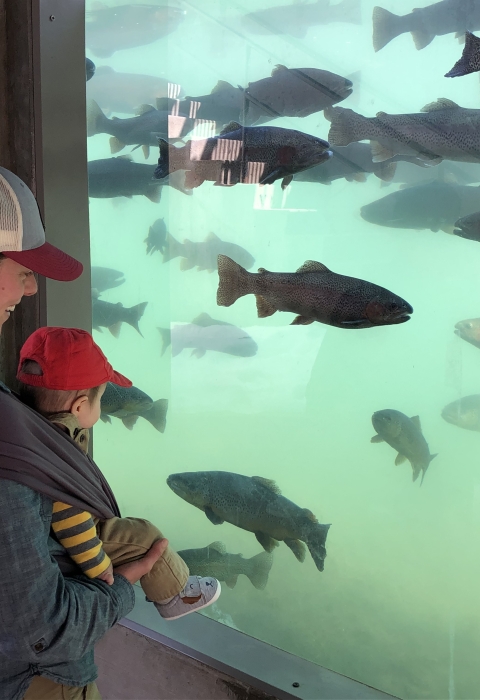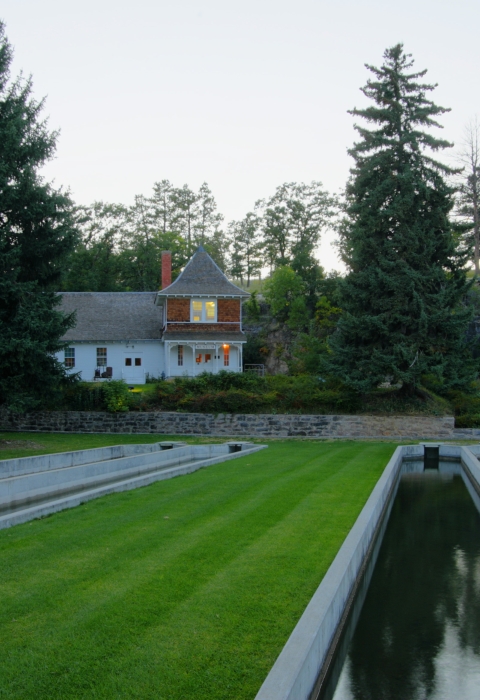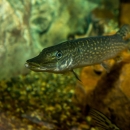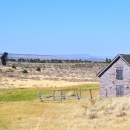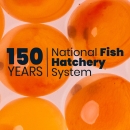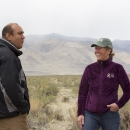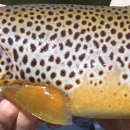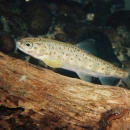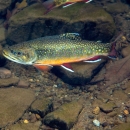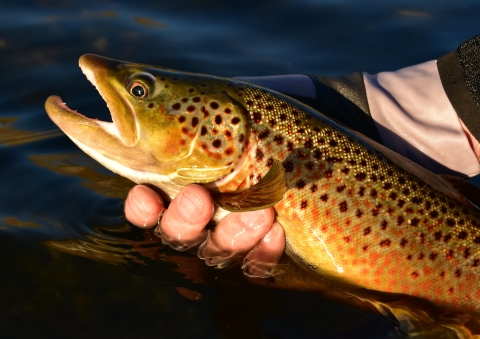Visit Us
Admission to the Hatchery grounds is always free. Visitors are welcome to stroll the hatchery grounds from dawn to dusk any day of the week, 365 days a year. However, the Pond Gift Shop, Von Bayer Museum, Railcar, and Booth House are only open during the summer season from mid-May through the end of September. Tours through the historic buildings are available through September from 9am to 6pm, on a rolling as-come, as-needed basis. Stop by for great interpretive tours from our volunteers!
Please note: Because the Hatchery’s attractions operate with the help of local and traveling volunteers, hours may vary or be shortened without notice.
Directions
From I-90 Interstate: Take Exit 12, travel west on Jackson Blvd, turn left on Canyon Street and continue south six blocks.
From Spearfish Canyon: Hwy 14A – Turn left at the stoplight on Colorado Blvd, turn left on Hudson St, turn left on Canyon St. -drive 6 blocks to City Park. NOTE: Spearfish Canyon via Winterville Road to Canyon Street is closed to thru traffic during summer months.
Location and Contact Information
About Us
Since 1871 the National Fish Hatchery system has been at work improving recreational fishing and restoring aquatic species that are in decline, at risk, and are important to the health of our aquatic systems. Across the country the network of National Fish Hatcheries work with states and tribes to conserve, restore and enhance the fish and aquatic resources of America for future generations.
Established in 1896, D.C. Booth Historic National Fish Hatchery and Archives, formerly Spearfish National Fish Hatchery, is one of the oldest operating hatcheries in the country. Dedicated to fish culture and resource management, the hatchery was constructed to propagate, stock, and establish trout populations in the Black Hills of South Dakota and Wyoming.
Still rearing trout for tribal and military waters through cooperative efforts, D.C. Booth annually raises and stocks catchable-size trout at regional military bases and in the waters of eight Indian Reservations in South Dakota and eastern Montana. Stocking tribal lands not only provides recreational fishing opportunities, but also food and a boost in economically depressed areas while fulfilling tribal obligations on behalf of the U.S. Fish & Wildlife Service.
The hatchery is also has a museum, multiple historic structures to tour and is on the National Register of Historic Places. Additionally, the hatchery houses the National Fish & Aquatic Conservation Archives that serves to protect and preserve our nation’s fishery records and artifacts for educational, research, and historic purposes. With over 180,000 visitors and 14,000 volunteer hours annually, the facility also strives to provide interpretive and educational programs for the public.
Tours
The museum
The Von Bayer Museum of Fish Culture was created to preserve the vibrant history and rich heritage of the American fisheries workers. The National Fish & Aquatic Conservation Archives, housed on the hatchery grounds, collects and preserves the historic objects from national fish hatcheries throughout the country making them accessible to researchers and the public.
The collection contains over 14,000 objects and 1.8 million archival records and is the largest collection of fisheries artifacts in the country. A sampling of artifacts are on display in the museum. The museum is open daily during the summer season. The collection management facility is open only by appointment.
Fish car #3
Before the invention of refrigerated tanker trucks, fish hatcheries were faced with the problem of how to quickly move fish from hatcheries to lakes and rivers around the country.
D.C. Booth displays the only federal fisheries railcar exhibit in the country, showcasing a replica of Fish Car No. 3. Visitors to this unique and beautifully restored railcar will learn about the history of the Fish Car Era, a 66-year period that played a key role in fisheries propagation.
The Booth House
The original 1905 superintendents house, also called the Booth House, features two expansive porches with classical columns, oval windows, a bay window, and a rear balcony. Generally unaltered from historic times, the interior is appointed with period furnishings and Booth Family memorabilia. DeWitt Clinton (D.C.) Booth was the first superintendent of the hatchery.
The Yellowstone Boat
U.S. Fisheries Boat #39, a wooden Great Lakes-style cabin cruiser, tells the story of early hatchery workers who went on expeditions to Yellowstone National Park to collect trout eggs. In 1901, the Spearfish National Fish Hatchery began to operate an egg-gathering substation in Yellowstone National Park.
The Yellowstone Boat was restored and is now on display at the D.C. Booth Fish Hatchery.
The grounds
Spanning 10 acres, the entire hatchery site is listed on the National Register of Historic Places. Ponds, rock walls, water systems and buildings contribute to the site’s historic significance. Although many alterations have been made on the site over the years, each change tells a story about hatchery operations.
Two hiking trails outline the boundaries of the hatchery site and serve as firebreaks. The trails offer scenic overlooks of the grounds and take you to historic sites such as reservoirs and the mort pit.
The visitor center and nature store offers fish food, books on nature and local history, wildlife and nature crafts & toys, gifts, and hatchery souvenirs. Visit the nature store for information about area attractions and the history of the hatchery.
The fish
Visitors can get up close and personal with brown and rainbow trout by feeding them from above or watching them through the underwater viewing windows. Visitors can feed the fish 365 days a year, as the grounds are open from dawn to dusk.
Trout from the hatchery are stocked in regional military and tribal waters.
What We Do
Established in 1896 to propagate, stock and establish trout populations in the Black Hills of South Dakota and Wyoming, the D.C. Booth Historic National Fish Hatchery—previously named Spearfish National Fish Hatchery—is dedicated to fish culture and resource management. The station currently produces trout for recreational fishing on tribal lands in South Dakota and Eastern Montana and regional military waters. Listed on the National Historic Register, the hatchery’s mission and partnerships strive to preserve the U.S. Fish and Wildlife Service’s historic and cultural heritage for educational, research, and historical purposes and provide interpretive and educational programs to the public. The hatchery provides free educational outreach to over 180,000 visitors annually who tour the fisheries museum, Fish Car #3, the historic superintendent's house, and the grounds where they learn about the history of fisheries work in America as well as current fish culture.
Our Organization
Since 1871, National Fish Hatcheries, including D.C. Booth Historic National Fish Hatchery, have been responding to conservation challenges affecting America’s fish and other aquatic species. Producing fish continues to be an irreplaceable tool in managing or restoring fisheries along with habitat conservation. In doing so, we help provide recreation opportunities to America’s 34 million anglers who spend $36 billion annually in pursuit of their favored pastime.
Projects and Research
Double YY Chromosome Brown trout
D.C. Booth is partnering with Idaho Game, Fish & Parks and McNenny State Fish Hatchery (SD) on new research to eradicate non-native trout via double YY chromosomes. It may seem counter-intuitive, but in addition to raising and stocking fish, fish hatcheries can also be used to reduce or eradicate unwanted fish populations. Idaho Fish and Game researchers are studying whether using traditional hatchery technology in a nontraditional way can eliminate undesirable fish populations in the wild.
Selectively breeding fish to get an entire population to produce one gender is routinely done in commercial aquaculture hatcheries to raise identical looking food fish and increase growth rates. This 50 year-old technology is being used to develop fish populations whose offspring can only produce males. These males have two YY chromosomes rather than the XY arrangement. By stocking YY-male hatchery fish into a body of water with an undesired fish in it (such as a non-native trout out-competing native trout in certain areas) could change the ratio to all males within a few generations and thus cause them to die out. Once accomplished fisheries managers would then restock the body of water with the desirable fish species.
D.C. Booth has partnered with McNenny State Hatchery (SD) to assist Idaho Game and Fish with the effort by creating a brown trout broodstock broodstock
The reproductively mature adults in a population that breed (or spawn) and produce more individuals (offspring or progeny).
Learn more about broodstock . Idaho had promising results with Brook trout and the “YY male” method is being looked at to eradicate or limit other undesirable fish species that limit game fish populations, native populations or harm habitats.
The brown trout eggs came from the FWS Saratoga National Fish Hatchery (WY), were hatched at McNenny and are now at D.C. Booth where they will be grown out for two years. “We are looking at the possibility that D.C. Booth would be home to one or more YY broodstocks that in the future would be used for eradication purposes,” says D.C. Booth Hatchery superintendent, Carlos Martinez.
During the time that the brown trout are being cared for at D.C. Booth, Idaho Game and Fish staff are periodically testing the efficacy of the process. Martinez said there is some speculation that the brown trout could revert back to being XY males later in their maturation cycle, so that will be monitored closely.
